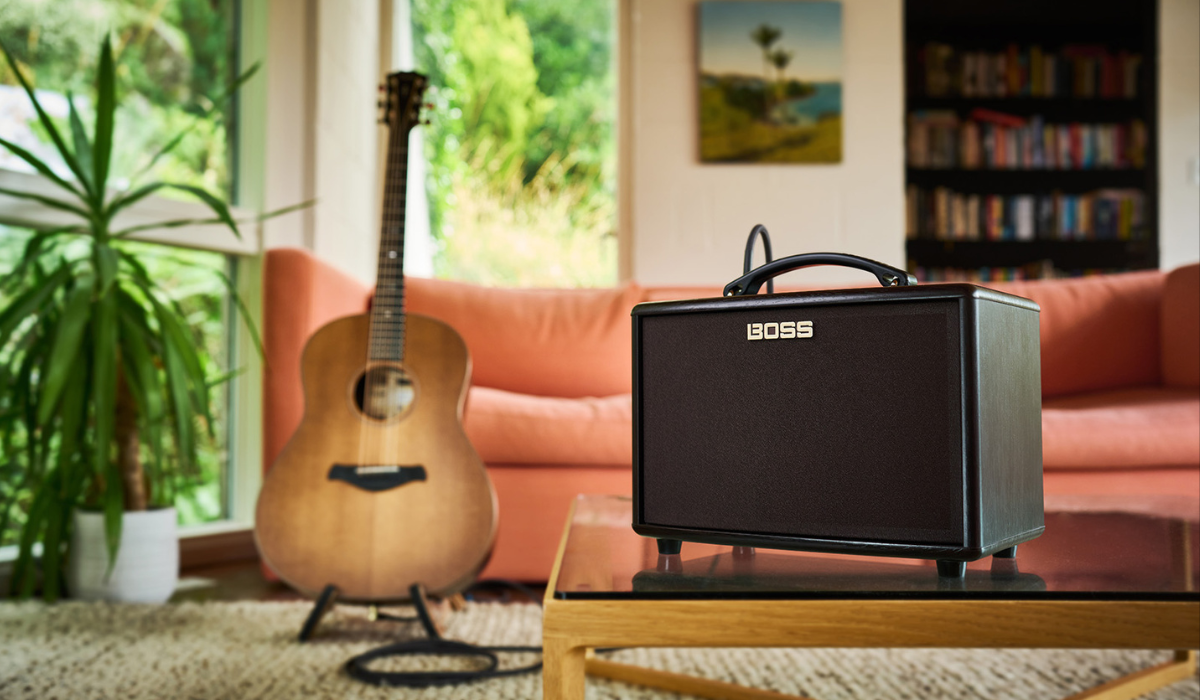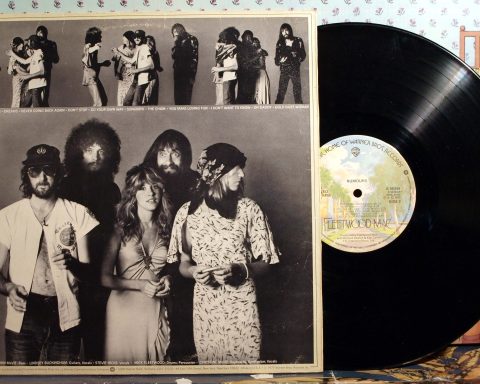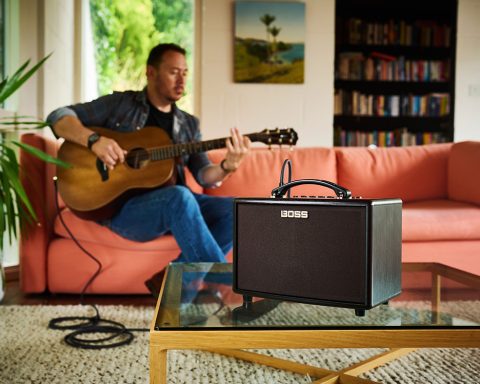There’s a beautiful simplicity to an acoustic guitar played raw. But an unplugged performance will only take you so far. As shows get bigger and recordings grow more professional, you’ll soon face the burning question that no troubadour can ignore. How do you power up and command an audience while retaining the glorious acoustic tone that makes your songs fly? Here’s everything you need to know about acoustic guitar amplifiers.
What is an Acoustic Guitar Amp?
At first glance, on a darkened stage, you could easily mistake an acoustic amp for a standard electric combo. Plug in, though, and you’ll soon realize the significant departure is under the bonnet. You can technically run an acoustic guitar through an electric amp when messing around at home. Unless you use a BOSS Katana on the specially voiced acoustic setting, it’ll be a feedback-howling disaster.
But if you’re discerning about your tone, an acoustic amp is non-negotiable for performance and recording. These models complement all the properties of an acoustic guitar. They factor in everything from the piezo pickup beneath the bridge to the expanse of air in the chamber of a plus-size dreadnought. Once you’ve played through a great acoustic amp, anything else will feel like using a wrench for a job that demands a screwdriver.
Wide Open
With rare exceptions, acoustic amps are compact solid-state combos, often finished with a woodsy chassis. But if all that suggests this amp type is a no-frills workhorse, you still need to meet the new BOSS AC-22LX.
If you’re at a tipping point in your music career, then your timing couldn’t be better. The perfect solution could be an acoustic amp. The BOSS AC-22LX offers ultra-natural mic’d up acoustic tone in a plug-and-play 10-watt combo. Plus, it has onboard effects, a rhythm box, USB connectivity, and more. The acoustic amp scene has never been so wide open for players taking the next step.
"Acoustic combos can make an instrument sound unbeatably natural and transparent."
Why Use an Acoustic Guitar Amp?
Many players choose an acoustic amp for the purity of tone. Average electric amps work on the assumption players want to change their sound. By contrast, acoustic combos can make an instrument sound unbeatably natural and transparent. Find a good one, and what you hear through the speaker is what you’d get in front of an unplugged player’s soundhole.
But acoustic guitar amps serve as more than just a blank canvas. Using the onboard EQ and tone-shaping features, a great acoustic amp can improve your tone, letting you compensate for a mediocre pickup. Meanwhile, if a clean voice is less important to you than crafting a head-turning sound, you can also use onboard effects to push the envelope. That’s before we get into the deeper functionality of a modern acoustic guitar amp like the BOSS AC-22LX, which features everything from deep sound editing to USB connectivity for hassle-free recording and livestreaming.
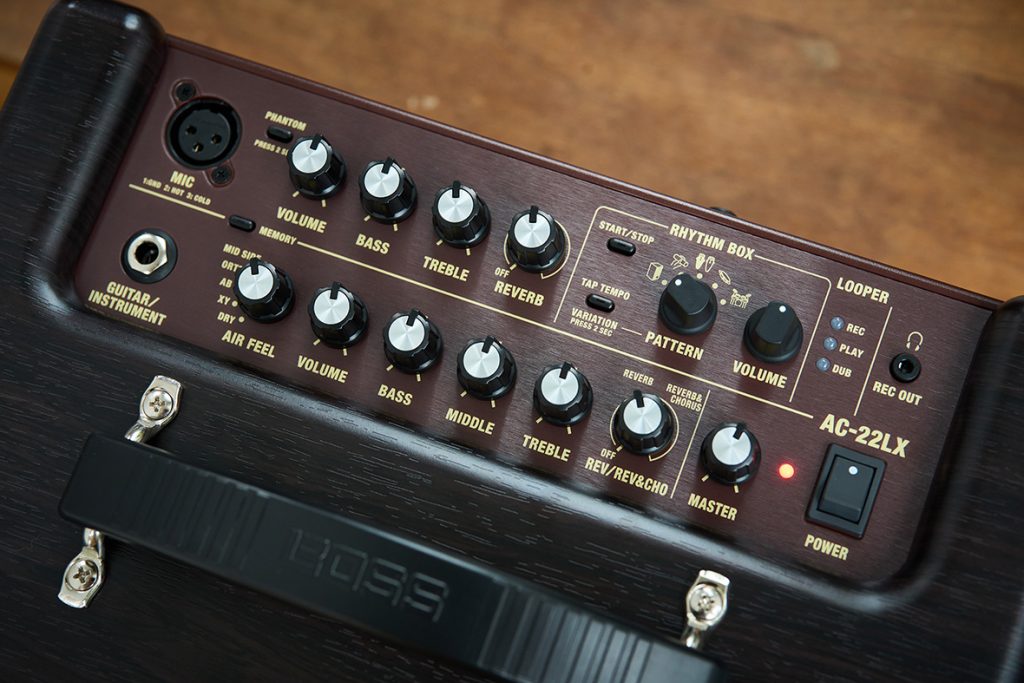
Common Acoustic Amp Controls
Check out the dashboards and back panels of a few leading acoustic amps, and you’ll see that most models have common ground and standout features. If sculpting your acoustic tone is a priority, choose an amp with a flexible three-band EQ (treble, mid, bass). Suppose you plan to accompany yourself as a singer-songwriter. In that case, insisting on a separate mic channel/input offering a dedicated EQ makes sense. That’s a core feature of industry-standard acoustic amps like the BOSS Acoustic Singer.
Some of the best acoustic amps include onboard beats plus built-in dial-operated effects like reverb/chorus. Pro-level acoustic amps like the BOSS AC-22LX feature an integrated looper via an outboard footswitch. Whether you crave flexibility or a crystalline acoustic tone, draw up a wishlist, choose the amp that ticks your boxes, and try it out.
"If you're playing small venues, like a coffee shop or local bar, you'll want an acoustic amp with enough power to get the job done without a PA."
Using an Acoustic Guitar Amp at Small Venues
Choosing an acoustic guitar amp that reflects the rung you currently occupy on the live circuit is essential. But you also want one that will support you as you score bigger gigs. If you’re busking, look for a lightweight combo with AA battery power, built-in beats, onboard looper, and an XLR mic input. This way, you can stay out all day and make more ambitious music than just strumming unaccompanied chords.
Moving on, if you’re playing small venues, like a coffee shop or local bar, you’ll want an acoustic amp with enough power to get the job done without a PA. The AC-22LX has a commanding 10-watt stereo output delivered through two custom 5-inch twin-cone speakers. This is more than enough to make your presence felt over chat and cappuccino machines.

Before you perform, devote some time to soundchecking. Fine-tune the AC-22LX’s EQ. Then choose one of the five Air Feel settings that emulate the response of a classic mic’d-up acoustic guitar. Finally, once you’ve dialed in a sound that suits that venue’s unique acoustics, save it to the AC-22LX memory bank so it’s ready when they invite you back.
Using an Acoustic Amp at Larger Venues
Once you start breaking into larger venues, several ways exist to amplify an acoustic guitar. The easiest option is to turn up with an instrument and roll the dice on the venue’s in-house PA system. But that’s a risky strategy. Even good-quality PA speakers are for generalized sound delivery and aren’t voiced for acoustic guitars. The resulting tone will be loud but potentially flat and lifeless.
One solution is to use an acoustic preamp pedal as part of your setup. If you go down this route, start by investigating BOSS’s ultra-compact AD-2 or its specced-up big brother, the AD-10. They’ll let you tailor your tone, send a fully balanced signal to the PA, and ensure that what hits the audience does you justice. If you’d prefer an even more straightforward connection, consider a DI box like the BOSS DI-1. It’s a simple way to convert high-impedance guitar output to the low-impedance balanced input that a mixing console needs to see.
"The mic-free and natural acoustic tone of a great amp like the AC-22LX can make a fingerpicked track burst from the speakers."
Microphones
Alternatively, there are microphones. Some acoustic connoisseurs feel the best way to capture depth, resonance, and dynamics is in front of the soundhole. Check out vintage footage of acoustic greats like Crosby, Stills, and Nash mic’ing up back in the day, and you’ll hear how sweet this approach can sound. But unless you have the time, expertise, and resources, mic’ing an amp when you’re third on a festival bill can be a hassle.
Fortunately, mic’ing an acoustic amp is no longer necessary. The most significant talking point on the new BOSS AC-22LX spec sheet is the revolutionary Air Feel feature. Where piezo pickups can sound sterile, this spatial technology recreates the sonic character of a mic’d acoustic. It captures the boom of the body bracing, the subtle response of the soundboard, and the movement of air in the room.
You can select five Air Feel settings with a twist of the dial. They range from the coincident pair-style emulation of XY to the spaced-pair voicing of AB. It’s like having an engineer at your disposal. In addition, the AC-22LX has a stereo line output to send sounds—including Air Feel—directly to the PA.
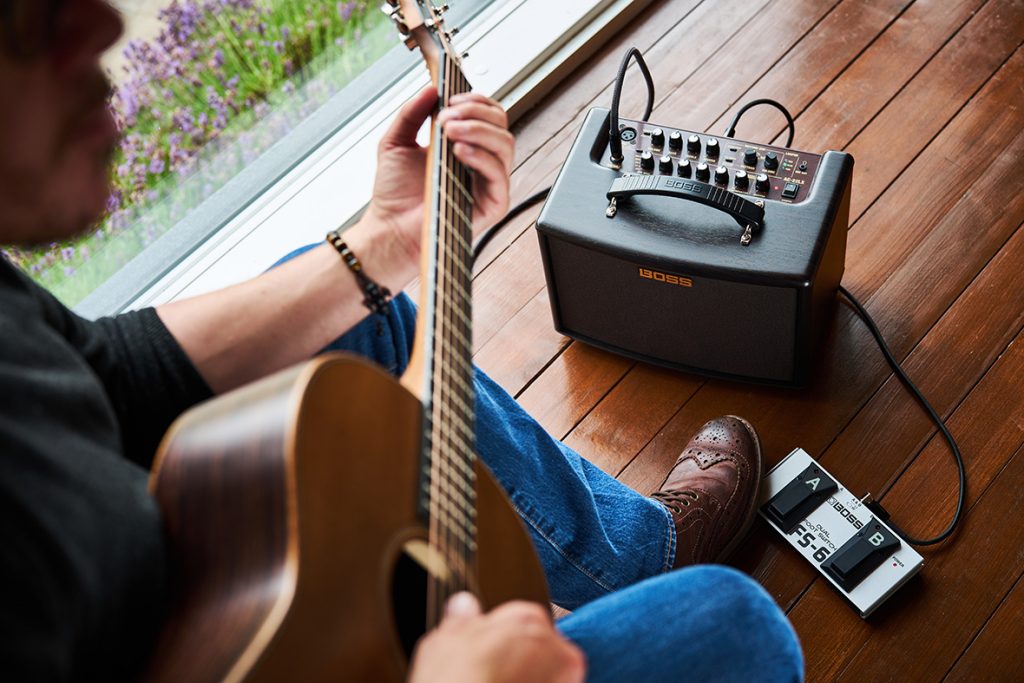
Acoustic Guitar Amp at Home
Uninitiated players often think of acoustic guitar amps as primarily a tool for the stage. However, the features of a modern combo can thrive as the cornerstone of a home recording setup or livestream rig. Look for a model that offers open-ended connectivity, including mono/stereo line out and USB, to cover you in every scenario.
When recording to a DAW, the mic-free and natural acoustic tone of a great amp like the AC-22LX can make a fingerpicked track burst from the speakers. This is especially true when you flavor the sound with Air Feel voicings. And if a particular song demands a tone to match, download the AC-22LX Editor app onto your phone. Then, fine-tune every last element of the sound—down to the reverb type.
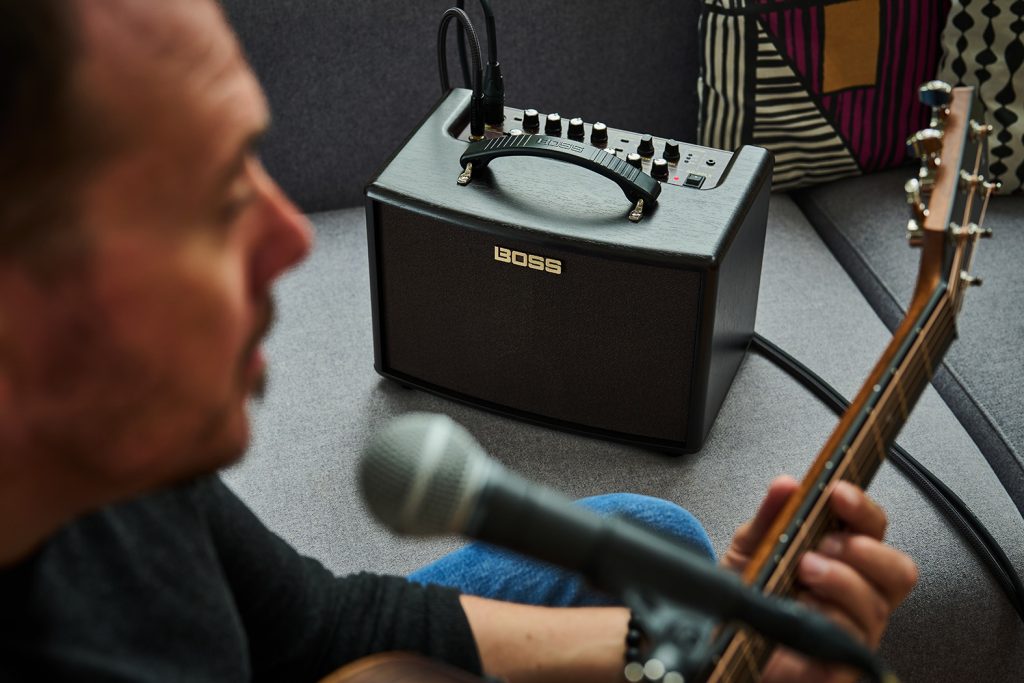
Streaming
When it comes to online performances, you can livestream to all your social media platforms. The Loopback function lets you monitor sounds from a computer and a headphone option if you’d rather keep things private. Finally, solo practice is much more fun when you choose an amp with the option of a Bluetooth® Audio MIDI Dual Adaptor. This feature lets you stream audio from your mobile device and play along. The bottom line is acoustic amps are far more than road warriors.
"The Loopback function lets you monitor sounds from a computer and a headphone option if you'd rather keep things private."
BOSS Acoustic Guitar Amps
Alongside revered effects and amps, BOSS sets the standard for acoustic players with acclaimed combos. These include the Acoustic Singer range and the new AC-22LX. Click here to explore the complete BOSS acoustic guitar amp range and discover the natural voice of your acoustic.

